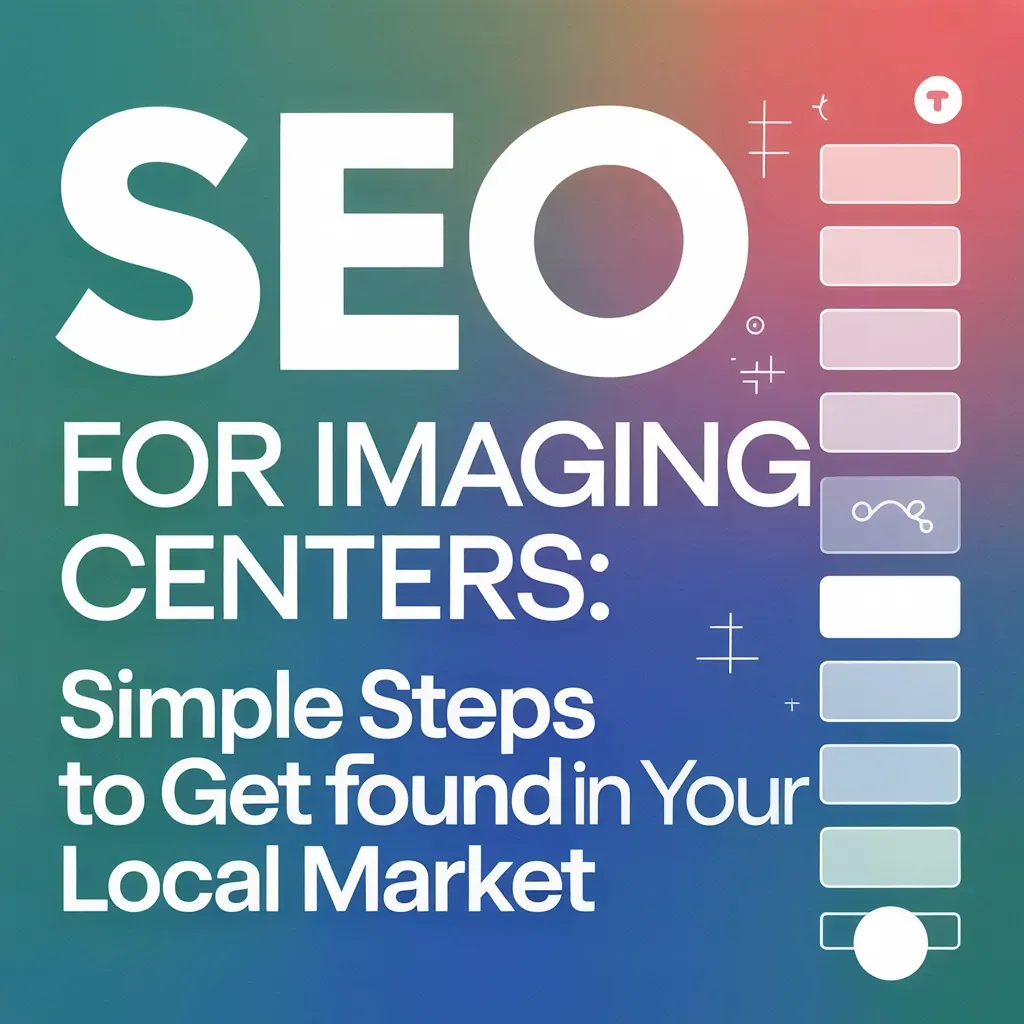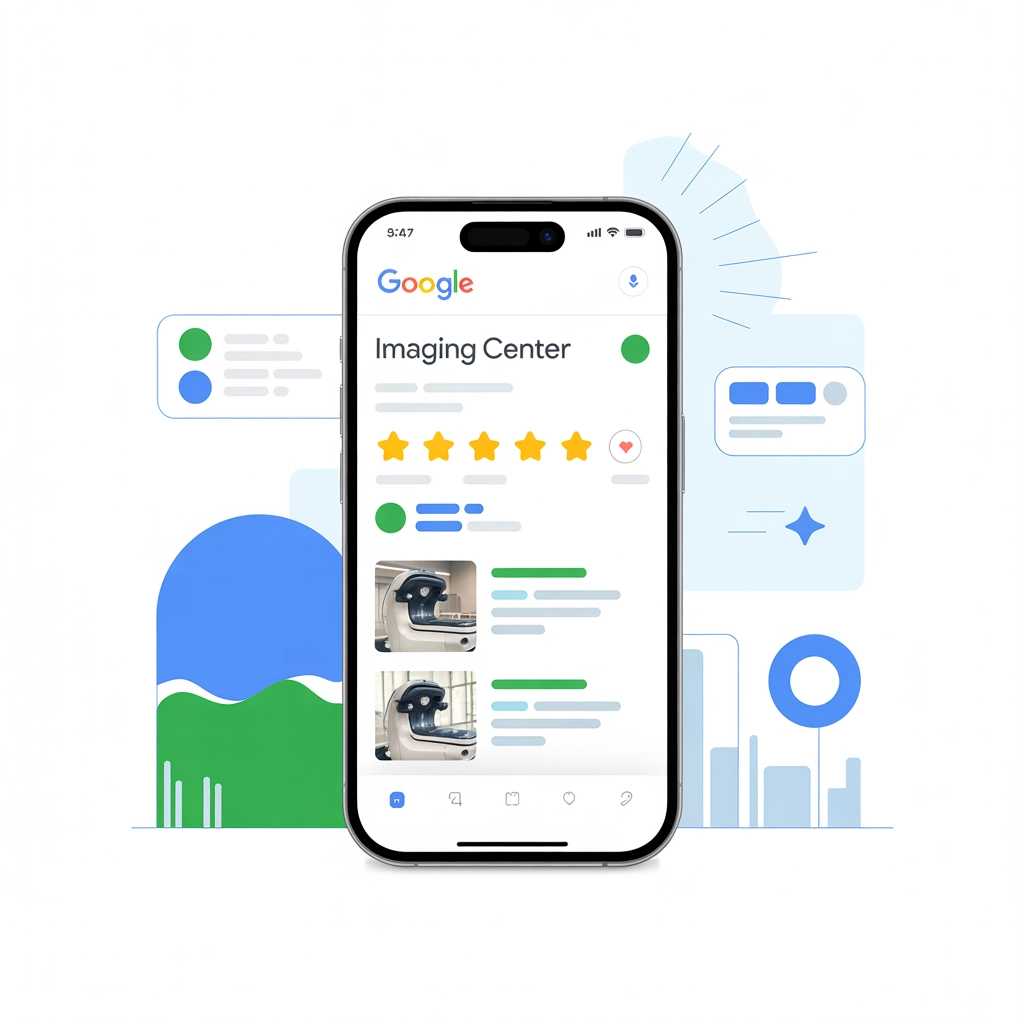
Simple Steps to Get Found in Your Local Market with SEO for Your Imaging Center(s)
The Digital Front Door to Your Imaging Center
In today's healthcare landscape, patients are increasingly turning to search engines to find medical services. For imaging centers, being discoverable online isn't just a marketing luxury; it's a business necessity. According to recent studies, 77% of patients use search engines before booking medical appointments, with 76% of those searches specifically looking for local healthcare providers.
The challenge for many imaging centers isn't offering quality services—it's making sure potential patients can find those services when searching online. Whether a referring physician is seeking a reliable partner or a patient is searching for "MRI near me," your digital visibility has a direct impact on your appointment calendar.
This guide will walk you through practical, actionable SEO strategies specifically designed for imaging centers looking to improve their local market presence without getting lost in technical jargon or complicated processes.
Why Local SEO Matters for Imaging Centers
Imaging services are inherently local. Patients rarely travel more than 20 miles for routine imaging procedures unless specialized equipment or expertise is required. This makes local search engine optimization (SEO) crucial for radiology practices and imaging centers.
"Local SEO is the single most cost-effective marketing channel for healthcare providers serving specific geographic areas," says Dr. Michael Roberts, healthcare marketing specialist at Mixed Media Ventures. "For imaging centers specifically, optimizing for local search can deliver a 4-to-1 return on investment within the first year."
Here's why local SEO deserves your attention:
46% of all Google searches have local intent
97% of consumers look online for local businesses
28% of local searches result in a conversion (call, visit, or appointment)
92% of patients read online reviews for healthcare providers
Let's explore the specific strategies that will help your imaging center stand out in local search results.
Optimize Your Google Business Profile (The Foundation)
Your Google Business Profile (formerly Google My Business) is the cornerstone of local SEO success. This free business listing appears in Google Maps, local search results, and the knowledge panel on the right side of search results.
For imaging centers, an optimized GBP is non-negotiable for several reasons:
It powers your visibility in "near me" searches
It displays critical information patients need before calling
It houses your reviews (a key decision factor for patients)
It provides analytics on how people find and interact with your listing
Here's how to optimize your Google Business Profile for maximum impact:
Complete Every Possible Field
Business name: Use your exact business name without keywords
Primary category: Choose "Diagnostic Imaging Center" or "Radiology Clinic"
Secondary categories: Add relevant options like "Medical Diagnostic Imaging Center" or "MRI Center."
Address: Ensure consistency with your website and other directories
Service area: Add additional cities/neighborhoods you serve
Hours: Include special hours for holidays and any after-hours emergency services
Attributes: Select all that apply (appointment required, wheelchair accessible, etc.)
Services: List all imaging modalities offered (MRI, CT, Ultrasound, X-ray, etc.)
Add High-Quality Photos
Patients want to know what to expect when visiting your facility. Include:
Exterior building shots from street view
Reception/waiting area
Equipment rooms (showing clean, modern technology)
Staff photos (with permission)
Patient preparation areas

Implement a Review Generation Strategy
Reviews impact both your ranking and patient conversion rates. Create a systematic approach:
Train staff to ask satisfied patients for reviews
Send follow-up emails with direct links to your GBP review form
Respond to all reviews—positive and negative—within 24-48 hours
Address negative feedback professionally and offer to take the conversation offline
Local Keyword Strategy for Imaging Centers
While general SEO principles apply to healthcare, imaging centers benefit from a highly specialized approach to keyword targeting. The goal is to capture patients searching for specific procedures in your service area.
Primary Keyword Categories
Service + Location Keywords
MRI center in [city name]
CT scan [neighborhood] [city]
Mammogram screening [city] [state]
Open MRI near [landmark]
Symptom/Condition + Imaging Keywords
Knee pain MRI [city]
Back injury imaging center [city]
Sports injury scan [neighborhood]
Insurance/Cost Keywords
Affordable MRI [city]
[Insurance provider] covered mammogram [city]
Low cost imaging center [city]
Urgency/Availability Keywords
Same-day CT scan [city]
Walk-in X-ray [city]
Next-day MRI appointment [city]
Implementing Keywords Effectively
Don't just stuff keywords throughout your site. Strategic placement is key:
Page titles: Include primary service + location (e.g., "Open MRI Services in Boston, MA | Center Name")
Meta descriptions: Expand with secondary keywords (e.g., "Same-day appointments for open MRI scans in downtown Boston. Insurance accepted.")
Headers (H1, H2, H3): Incorporate service names and location modifiers
URL structure: Create location-specific service pages (e.g.,
/services/mri/boston)Content body: Use natural language variations of your keywords
Image alt text: Describe images with service and location terms
For multi-location imaging centers, create individual location pages that target specific neighborhoods or cities, each optimized for local search terms.
On-Page SEO Optimization for Imaging Center Websites
Your website serves as both an information resource and a patient acquisition tool. These technical optimizations help search engines understand, index, and rank your content appropriately.
Technical Foundation
Mobile Optimization: Ensure your site displays properly on smartphones and tablets, as 61% of healthcare searches occur on mobile devices
Page Speed: Compress images, leverage browser caching, and minimize code to achieve load times under 3 seconds
Secure Connection: Implement HTTPS to protect patient information and improve rankings
Clean URL Structure: Create logical paths that include keywords (e.g.,
/services/mriinstead of/page-id-123)
Schema Markup Implementation
Schema markup helps search engines understand the content and context of your pages. For imaging centers, implement:
LocalBusiness schema
MedicalOrganization schema
MedicalProcedure schema for individual services
This structured data can help your site appear in rich results and knowledge panels. Here's a simplified example of schema markup for an MRI service:
Service Page Optimization
Each imaging modality should have its own dedicated page optimized for both search engines and patient information needs:
Clear service descriptions explaining the procedure in patient-friendly language
Preparation instructions to help patients arrive ready
Equipment specifications highlighting technology advantages
Insurance information and typical costs
FAQ section addressing common patient concerns
CTAs for scheduling prominently displayed

Content Strategy That Drives Patient Acquisition
Content marketing for imaging centers should balance educational value with strategic keyword targeting. The goal is to answer patient questions while establishing your center as an authority.
Blog Content Categories
Procedure Explanations:
"What to Expect During Your First MRI"
"CT Scan vs. X-ray: Understanding the Differences"
"5 Ways to Reduce Anxiety Before Your Imaging Appointment"
Physician Resources:
"When to Order Contrast vs. Non-Contrast CT Studies"
"Latest Advances in 3T MRI Technology"
"Appropriate Use Criteria for Common Imaging Studies"
Insurance & Cost Information:
"Understanding Insurance Coverage for Preventive Imaging"
"Self-Pay Options for Imaging Services: What Patients Need to Know"
"HSA and FSA Coverage for Diagnostic Imaging"
Condition-Specific Content:
"The Role of MRI in Diagnosing Sports Injuries"
"Mammography Guidelines: When to Start and How Often"
"Using Ultrasound to Diagnose Common Pregnancy Complications"
Content Distribution Channels
Creating content is only half the battle. Distribution matters just as much:
Email newsletters to referring physicians and patients
Social media posts highlighting key points from longer content
Local health publications for contributed articles
Physician lunch-and-learns based on educational content
Patient education materials in your waiting room
"The imaging centers seeing the most success with content marketing are those who repurpose single pieces of content across multiple channels," notes Sarah Johnson, Digital Content Strategist at Conversation Assist, by Mixed Media Ventures. "A blog post becomes a social graphic, an email newsletter, and talking points for referring physician outreach."
Learn more about content marketing strategies in our guide on why imaging centers should use content marketing.
Local Citations and Link Building
Citations are mentions of your business name, address, and phone number (NAP) across the web, while links are clickable references to your website. Both play crucial roles in local SEO for imaging centers.
Citation Building Strategy
Claim primary directories:
Healthgrades
Vitals
WebMD Provider Directory
Yelp
Yellow Pages
Bing Places
Add healthcare-specific directories:
ZocDoc
RateMDs
Local hospital physician referral networks
Maintain NAP consistency:
Use exactly the same business name, address format, and phone number across all platforms
If you have multiple locations, create separate listings for each
Local Link Building Tactics
Local health partnerships:
Cross-promote with complementary providers (orthopedists, neurologists)
Sponsor local health events and request backlinks
Offer educational content to community health organizations
Local media relations:
Share newsworthy equipment acquisitions or technology upgrades
Offer expert commentary on local health issues
Create imaging-related public service announcements
Educational resources:
Create downloadable patient preparation guides that others will link to
Develop physician-focused resources that medical practices will reference
Publish research or case studies in collaboration with local healthcare providers

Monitoring and Refining Your SEO Strategy
SEO isn't a "set it and forget it" endeavor. Regular monitoring and refinement are essential for long-term success.
Key Metrics to Track
Search visibility:
Ranking for target keywords
Appearance in map packs
Featured snippet inclusion
Traffic metrics:
Organic search traffic volume
Geographic distribution of visitors
Mobile vs. desktop users
Engagement metrics:
Pages per session
Average time on site
Bounce rate by page
Conversion metrics:
Appointment request form completions
Phone calls from the website
Online scheduling utilization
Recommended Tools
Google Analytics: Track website traffic and user behavior
Google Search Console: Monitor search performance and technical issues
Google Business Profile Insights: Analyze local search performance
SEMrush or Ahrefs: Research keywords and monitor rankings
Call tracking software: Attribute phone calls to marketing channels
Refinement Process
Implement a quarterly review cycle:
Analyze performance data and identify content gaps
Update service pages with fresh information
Add new location pages as you expand
Refresh outdated blog content
Solicit new reviews from satisfied patients
Check and update citations across the web
For help with analyzing your SEO performance, consider exploring Sales Pilot CRM for tracking patient acquisition sources and marketing ROI.
Competitive Analysis for Market Differentiation
Understanding your local competition is critical for effective SEO. Conduct regular competitive analysis to identify opportunities:
Identify top-ranking competitors for your primary keywords
Analyze their service offerings and digital messaging
Evaluate their Google Business Profile (review count, post frequency)
Review their website structure and content strategy
Identify gaps they're not addressing in their digital presence
Use these insights to differentiate your imaging center:
If competitors focus on equipment specifications, emphasize your patient experience
If they lack educational content, create comprehensive resources
If they don't highlight insurance coverage, make your financial information transparent
If their appointment process is complex, promote your simplified scheduling
Learn more about competitive differentiation in our article on why imaging diagnostic centers should understand upselling.
Summary: Your Local SEO Action Plan
Implementing effective SEO for your imaging center doesn't have to be overwhelming. Focus on these key priorities:
Optimize your Google Business Profile completely with accurate information, photos, and a review generation strategy
Implement local keywords throughout your website, particularly in titles, headers, and service pages
Create location-specific landing pages if you serve multiple areas
Add schema markup to help search engines understand your services
Develop educational content that answers patient questions while incorporating relevant keywords
Build consistent citations across healthcare directories
Monitor performance and refine your approach quarterly
The most successful imaging centers treat SEO as an ongoing process rather than a one-time project. By consistently applying these strategies, you'll improve visibility, attract more patients, and strengthen referral relationships in your community.
Ready to Improve Your Imaging Center's Digital Visibility?
At Imaging Media Group, we specialize in helping diagnostic imaging centers implement effective digital marketing strategies that drive appointment volume and strengthen referral networks. Our healthcare marketing experts understand the unique challenges and opportunities in the imaging space.
Want to see how your center's current SEO performance measures up? Contact us today for a complimentary SEO audit that will identify your biggest opportunities for improvement and provide a clear roadmap for enhancing your local search visibility.
Don't let potential patients choose your competitors simply because they found them first. Take control of your digital presence and start growing your practice through strategic SEO implementation.
Still have questions? Want to see how we can help you achieve success? Reach out.
Use the form to the right to reach out to us and speak with a representative, and learn how you can grow your Imaging Center.
Let's Chat
Contact Us
© 2025 Imaging Media Group - All Rights Reserved
Imaging Media Group and SalesPilot CRM are divisions of Mixed Media Ventures

